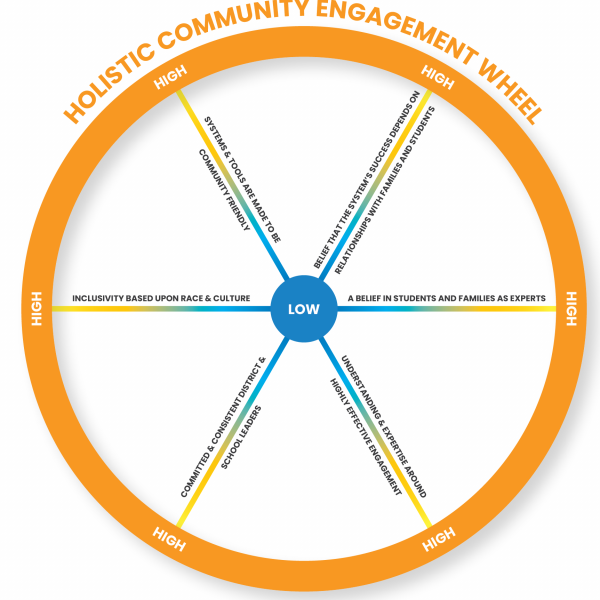What is the Holistic Engagement Wheel?
CEI developed The Holistic Engagement Wheel from the Six Essential Roots of Effective Community Engagement. The wheel is a tool that allows individuals and groups to assess their progress in developing and improving community engagement in their schools and districts. While there are many research-based ways to view and approach identifying strengths and areas of growth, this is one tool you can use with staff, families, students, and other stakeholders who are part of your community engagement efforts. It is community-friendly. Districts and schools can use it when they seek collaboration and consensus in analyzing progress toward effective community engagement efforts.
The Spokes
- Each spoke of the Holistic Engagement Wheel aligns with one of the Six Roots of Effective Community Engagement.
- The spoke represents a range of a root’s implementation. Closer to the wheel’s center are low implementation levels, and nearer to the wheel’s edges are considered higher implementation levels.
- As points are plotted on each spoke, users must consider what evidence contributes to the assessment.
How To Use The Holistic Engagement Wheel
Point Plot Example – Root 3
Root 3 is a strong understanding and expertise around highly effective student and family engagement. Here is how one would plot a point of the Holistic Engagement Wheel for Root 3.
- To assess this root, one must consider the Essential Root descriptions described earlier in the module. Consider them as questions:
- What efforts has a district or school undertaken to provide opportunities for staff to learn the research and frameworks that describe and explain highly effective engagement?
- Is there a common definition of meaningful and effective community engagement that expands beyond statute?
- How is a district or school measuring its community engagement and its impact on students?
- What community engagement resources and guidance are available to all staff?
- Are community engagement skills a factor considered in hiring decisions across diverse organizational roles?
- Is staff offered professional learning that provides critical skills in community engagement (relationship building, empathy/deep listening, understanding privilege, power, and cultural diversity) along with best practices and strategies for reaching marginalized families, students, and community members?
- In our example, let’s imagine the following: a user may note that their district offers professional learning for teachers and public-facing classified staff. And that the professional learning covers research and skill-building. Additionally, the district has a family and community engagement (FACE) consultant working with FACE staff. The user’s district doesn’t have a common definition or measure for community engagement and has not considered community engagement skills in hiring. Furthermore, not all staff can access professional learning opportunities. Finally, no evidence points to skills training in effectively engaging historically marginalized community members.
- Based on the example scenario, the plot point for Root 3 might look something like the following:



